By Amanda Durish Cook
The length of MISO’s lone market efficiency project for 2016 will have to be extended, increasing its cost by as much as one-quarter and reducing its benefit-cost ratio.
MISO said the estimated cost of the Huntley-Wilmarth 345-kV project has jumped by $20 million from the original $81 million as a result of having to reroute the line to bypass the Mankato, Minn., area.
MISO staff told the Oct. 19 Planning Advisory Committee meeting that the new benefit-cost ratio on the project may be as low as 1.5-to-1, down from the original 2-to-1.
MISO Senior Manager of Competitive Transmission Administration Brian Pedersen said the original line length was estimated at 38.5 miles. It’s unclear how many miles the reroute will add to the project, which is slated for completion in 2022.
Putting aside misgivings about the cost increase, a majority of PAC sectors approved a motion recommending that the 2016 Transmission Expansion Plan report proceed to the System Planning Committee of the Board of Directors for consideration. After that, the report will go before the Advisory Committee and Board of Directors for approval in December. (See MTEP 16 Proposes 394 Projects at $2.8 Billion.)
In a first round of feedback on MTEP 16, stakeholders urged MISO to competitively bid the line, despite Minnesota’s right-of-first-refusal statute, which would designate the project to incumbents Xcel and ITC.
“This is an issue we see no matter who does it,” an Xcel representative told stakeholders. “It’s still an urban area; it still needs to be addressed. This is the difference between the planning estimate and what the route actually is.”
Hwikwon Ham of the Minnesota Public Utilities Commission “strongly” urged Xcel to come before the state’s Department of Commerce — which advocates to the PUC on behalf of consumers — to discuss the change.
Steve Leovy of WPPI Energy asked why MISO had not presented a more accurate cost estimate when it initially rolled out MTEP 16.
John Lawhorn, senior director of policy and economic studies at MISO, said the RTO does “the best job it can.”
“Cost estimates and actual costs can vary, as you know, so we have variance analysis built into our Tariff,” Lawhorn said.
“We constantly hear MISO pushing openness in the process, and here it is again that we don’t have all the details. At a minimum, an MTEP report should at least present the best cost estimate possible,” said George Dawe, vice president of Duke-American Transmission Co.
However, Ham said he was pleased that Xcel came forward with the increased price before MTEP 16 is approved. “I’m happy to see this number came in ahead of time,” he said.
The MTEP report says the Huntley-Wilmarth project will give load more access to lower-cost generation because it “completely mitigates” congestion on the Huntley-Blue Earth 161-kV line near the Iowa-Minnesota border. The line has been stressed by large amounts of wind capacity and low-cost coal generation in northern Iowa.
“Further worsening congestion is the increase in wind capacity in Iowa that is assumed over the next 15 years,” the report says. “Finally, expected coal retirements near the Minneapolis/Saint Paul area such as Sherco 1, Sherco 2 and Clay Boswell 3 tend to increase the need for power to flow from northern Iowa to the Twin Cities via the Lakefield to Wilmarth 345-kV path. As a result, for the loss of this high-voltage transmission path, the low-voltage parallel path of Huntley to Blue Earth 161-kV becomes congested.”





